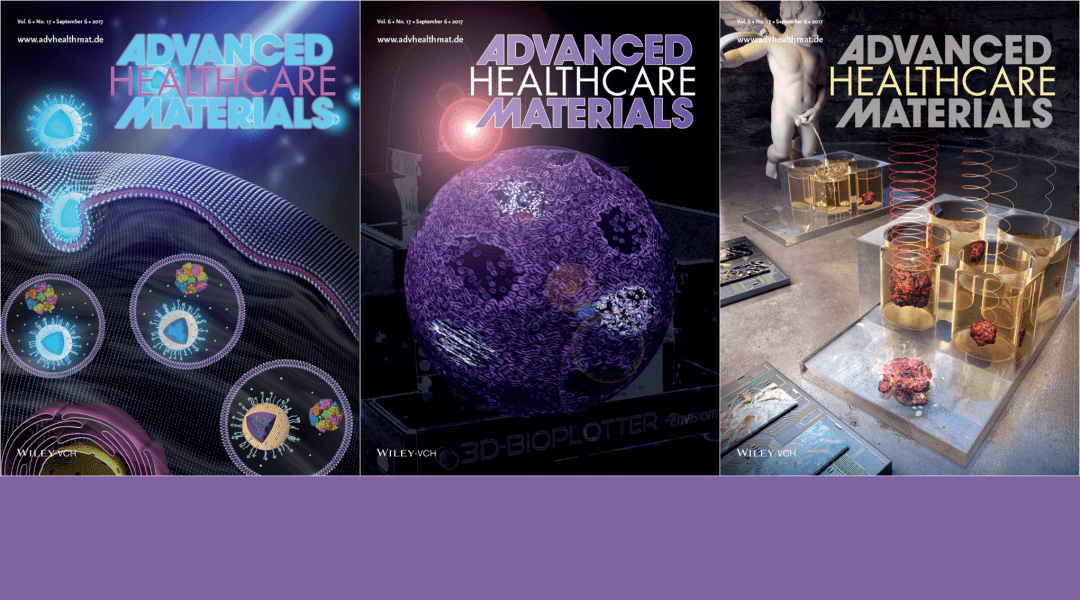Advanced Healthcare Materials celebrates its 5th birthday this year! Since 2012 we have been bringing you the latest breakthroughs in biomedical materials science with a strong focus on improving human health, and we will continue to do so in 2017. We therefore have launched virtual issues on five hot topics in the field, where you can access some of our best recent papers free of charge!
No access to our published content yet? Make sure to recommend Advanced Healthcare Materials to your librarian. More information can be found here.
In this biweekly feature, we highlight the artwork on the covers of the most recent issue of Advanced Healthcare Materials, and of course the research behind it. You can find this week’s issue here. Click on the titles or cover images below to get to the corresponding papers. Also check out our previous cover art feature and our monthly Most Read.
by Qi Gu, Eva Tomaskovic-Crook, Gordon G. Wallace, and Jeremy M. Crook
Jeremy Crook, Gordon Wallace, and co-workers at the University of Wollongong in Australia introduce a novel tissue engineering method involving 3D bioprinting of human induced pluripotent stem cells. Their approach creates cell-laden constructs with the capacity to form ectodermal, endodermal, and mesodermal tissues (exemplified by neuronal, lung, and muscle cells) and therefore all tissues of the body.
by Minhong Jeun, Sungwook Park, Yongdeok Kim, Jaewon Choi, Sang Hoon Song, In Gab Jeong, Choung-Soo Kim, and Kwan Hyi Lee
Kwan Hyi Lee and co-workers at the Korea Institute of Science and Technology and the University of Ulsan in Seoul describe an ion-responsive urine sensor for analyzing minuscule amounts of prostate cancer biomarkers. Patients’ untreated urine samples are loaded onto the sensor, and the resulting signals are proportional to the amount of the urine cancer biomarker within the patients’ urine. The resulting signals are also confirmed to be proportional to the size of the tumor volume measured from patients’ magnetic resonance images.
Multifunctional Polymeric Micelles for Combining Chelation and Detection of Iron in Living Cells
Polymeric Micelles for Combining Chelation and Detection of Iron in Living Cells
by Zhi Liu, Max Purro, Jing Qiao, and May P. Xiong
May Xiong and co-workers at the University of Georgia in Athens, USA constructed multifunctional Pluronics F127 micelles for iron chelation and fluorescence detection by introducing tetraphenylethene and the chelating drug deferoxamine into self-assembling polymeric micelles. Deferoxamine can simultaneously be used to chelate iron(III) and quench the fluorescence emission of tetraphenylethene. This fluorescence “turn-off” process can be used to monitor the iron chelation process in an iron overload cell model.
Multiplexed Optogenetic Stimulation of Neurons with Spectrum-Selective Upconversion Nanoparticles
Optogenetic Stimulation of Neurons with Spectrum-Selective Upconversion Nanoparticles
by Xudong Lin, Ying Wang, Xian Chen, Runhuai Yang, Zixun Wang, Jingyu Feng, Haitao Wang, King W. C. Lai, Jufang He, Feng Wang, and Peng Shi
An all-optical neural stimulation strategy is demonstrated by Feng Wang, Peng Shi, and co-workers at the City University of Hong Kong by utilizing spectrum-tunable NaYF4-based upconversion nanoparticles. These are used as transducers to absorb near-infrared energy and to emit visible light for stimulating neurons expressing channelrhodopsin proteins. Depending on the different dopants in the particles, the spectrum of their upconverted emission can be tuned to accommodate different opsin proteins for multiplexed and combinatorial neural stimulation, which is systematically characterized in cultured primary neurons as well as in rodent animals.
Carbon Nanomaterials in Biological Studies and Biomedicine
Nanomaterials in Biological Studies and Biomedicine
by Nagappa L. Teradal and Raz Jelinek
Raz Jelinek and Nagappa Teradal from the Ben Gurion University of the Negev in Israel highlight applications of carbon nanotubes, graphene, and carbon dots in biosensing, drug delivery, bioimaging, tissue engineering, and regenerative medicine in their Review. In particular, their unique physical properties and relative biocompatibility make carbon nanomaterials attractive vehicles for biological uses.
Interested in more news about Advanced Healthcare Materials? Also check out our previous cover art feature and our monthly Most Read.
We recently have released a top-level special issue on biomimetic interfaces in biomedical devices.
Discover our new virtual issues now too and read selected articles on nanotherapeutics, regenerative medicine, biofabrication, stem cells, and diagnostic devices for free.


 Bioprinting Human Induced Pluripotent Stem Cell Constructs for In Situ Cell Proliferation and Successive Multilineage Differentiation
Bioprinting Human Induced Pluripotent Stem Cell Constructs for In Situ Cell Proliferation and Successive Multilineage Differentiation Detection of ANXA3 from Untreated Urine of Prostate Cancer Patients without Digital Rectal Examination
Detection of ANXA3 from Untreated Urine of Prostate Cancer Patients without Digital Rectal Examination














